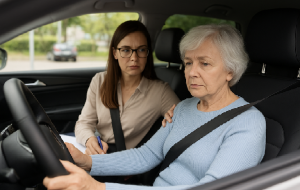 Driving is a symbol of independence for many seniors, but age-related changes in vision, cognition, and mobility can make driving unsafe. Recognizing the warning signs of unsafe driving is essential for protecting seniors and others on the road. Therapy can also provide emotional and practical support during this major life transition.
Driving is a symbol of independence for many seniors, but age-related changes in vision, cognition, and mobility can make driving unsafe. Recognizing the warning signs of unsafe driving is essential for protecting seniors and others on the road. Therapy can also provide emotional and practical support during this major life transition.
Key Signs a Senior May No Longer Be Fit to Drive
1. Physical Changes Affecting Driving
Decreased vision, including difficulty seeing at night or judging distances.
Slower reaction times and limited coordination.
Physical limitations due to arthritis, joint pain, or other conditions that make handling the car difficult.
2. Cognitive Changes
Forgetting familiar routes or getting lost easily.
Trouble making quick decisions in traffic.
Confusion at intersections or in unfamiliar areas.
3. Behavioral and Emotional Indicators
Increased stress, anxiety, or fear while driving.
Frequent near-misses or minor accidents.
Receiving multiple traffic citations or warnings.
4. Medical Concerns
Diagnosed conditions like dementia, Parkinson’s disease, or stroke that affect awareness.
Medications that cause drowsiness, dizziness, or slowed reaction times.
How Therapy Supports Seniors Through the Transition
Giving up driving can feel like a loss of freedom. Therapy offers strategies to cope with these changes and maintain independence:
1. Emotional Support
Therapists provide a safe space for seniors to express feelings of grief, frustration, or anxiety related to stopping driving.
2. Practical Solutions
Therapy can help seniors explore alternatives like public transit, rideshares, community shuttles, or family support to stay mobile.
3. Cognitive and Physical Skills Training
Occupational therapy can assess driving readiness, improve coordination, memory, and reaction time, and extend safe driving years when possible.
4. Family Guidance
Therapists can include family members to improve communication and reduce tension around the decision to stop driving.
Maintaining Independence Without a Car
Stopping driving doesn’t mean losing independence. Seniors can:
Participate in social activities using accessible transportation.
Use grocery delivery, online shopping, and community services to maintain routines.
Stay connected with friends and family through phone or video calls.
By recognizing the warning signs and integrating therapy, seniors can transition away from driving safely while preserving independence, confidence, and quality of life.
